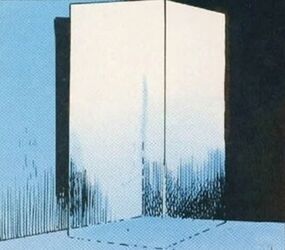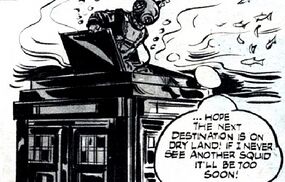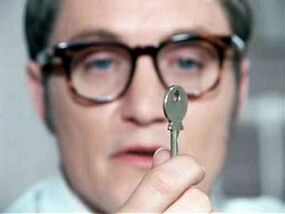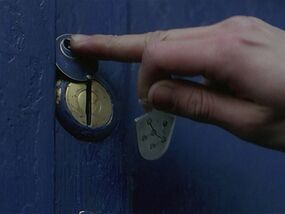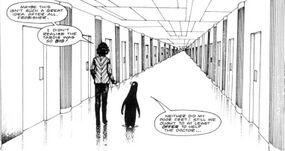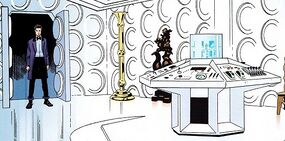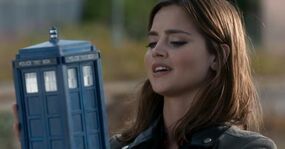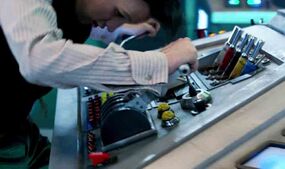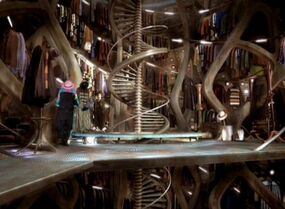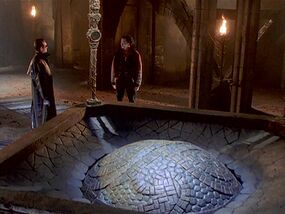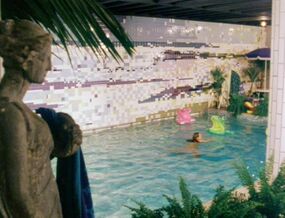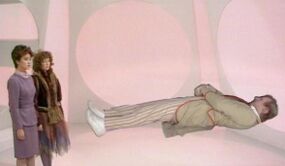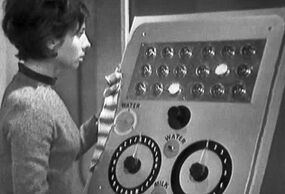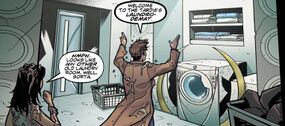The Doctor's TARDIS
- You may be looking for the Doctor's first TARDIS.
The Doctor's TARDIS — also called the Ship, the Box, and the TARDIS (PROSE: Time and Relative, COMIC: Food for Thought) — was the Doctor's primary means of transport. It was capable of travelling through space and time. The Doctor voyaged in his vessel from the Big Bang (TV: Terminus, Castrovalva, AUDIO: Slipback, PROSE: Nothing O'Clock) to the end of the universe. (TV: Utopia, Listen, AUDIO: The Chaos Pool, COMIC: Petals) The craft was also capable of travelling between parallel realities in spite of the fact that it was not specifically designed for inter-dimensional travel. (TV: Rise of the Cybermen)
Other Time Lords frequently characterised the Doctor's TARDIS as woefully out-of-date. (TV: The Claws of Axos, The Ribos Operation) Indeed, by at least the time of the Doctor's fourth incarnation, if not much earlier, the model — called a "Type 40" — had been pulled from general service on Gallifrey. (TV: The Deadly Assassin, The Invasion of Time)
The craft was prone to a number of technical faults, ranging from depleted resources (TV: An Unearthly Child, The Wheel in Space, Vengeance on Varos) to malfunctioning controls (TV: The Edge of Destruction) to a simple inability to arrive at the proper time or location. (TV: The Visitation, Attack of the Cybermen, The Eleventh Hour, Victory of the Daleks, The Girl Who Waited and many others) However, because the TARDIS was a living being, these "faults" may instead have been at least partially attributed to the manifestation of the ship's free will. Indeed, the TARDIS itself once told the Eleventh Doctor that it may not have always taken him where he wanted to go, it had always taken him to where he needed to go. (TV: The Doctor's Wife)
As the centuries passed and all of the Doctor's companions came and went, his faithful TARDIS remained his constant companion. They shared an unbreakable bond, and the Doctor came to feel that in the end, it was just him and his TARDIS. (AUDIO: The Girl Who Never Was, TV: The Doctor's Wife) Such was this bond, that, in an alternate timeline, the TARDIS eventually became the Doctor's final resting place, containing his personal time stream. (TV: The Name of the Doctor)
The Doctor's TARDIS was depicted in many cultures on Earth in a variety of forms, such as being depicting as the temple of the household "gods", the Tenth Doctor and Donna Noble, by Lobus Caecilius's family after they were rescued from the destruction of Pompeii , (TV: The Fires of Pompeii) being painted on a church's stained glass window after the Doctor "smote[d] [a] demon" at a convent in the 1300s, (TV: The End of Time) and the Eleventh Doctor using the power of its image to counter the influence of the Prometheans. (COMIC: Hunters of the Burning Stone) According to the Moment, the noise the TARDIS made when it appeared brought hope to anyone who heard it, no matter how lost they were. (TV: The Day of the Doctor)
Procurement
In his first incarnation, the Doctor implied he had built his TARDIS himself. (TV: The Chase) Whether there was some truth to this or not, he and others later stated that he had, in fact, stolen it. (TV: The War Games, Frontier in Space, Logopolis, Planet of the Dead, The Big Bang, The Doctor's Wife, The Time of the Doctor, Death in Heaven, COMIC: The World Shapers, AUDIO: Trial of the Valeyard) The TARDIS was once owned by the Time Lady Marianna (AUDIO: The Abandoned) and later by the Time Lord Marnal, and due to his exile at the time of the Doctor's procurement of the TARDIS, he claimed that the Doctor stole it. (PROSE: The Gallifrey Chronicles) Other accounts differ to this, and implied it came from the general, government-controlled "stockpile" of TARDISes after the model had been officially decommissioned. (TV: The Deadly Assassin, PROSE: The Exiles, COMIC: Time & Time Again) The Fourth Doctor told Adric that "it was in for repairs on Gallifrey when [he] borrowed it." When the Alzarian countered that he thought the Doctor outright owned the vehicle, the Doctor said, "Well, on a sort of 'finders, keepers' basis, yes." (TV: Logopolis)
When the Doctor first decided to leave Gallifrey, he had the chance to take a Type 53, but dismissed it as "soulless" in favour of the Type 40. (PROSE: Lungbarrow) The Doctor received a recommendation for this particular TARDIS from a version of future companion Clara Oswald. She actually stopped him from taking another TARDIS, saying that the navigation system on this one was "a bit knackered" but he'd have more fun with it. He took her suggestion. When the Doctor stole it, the TARDIS was in a repair shop and two Time Lords were surprised that anyone would want to steal it. (TV: The Name of the Doctor) The TARDIS itself said it was "a museum piece", though this may have been figurative. (TV: The Doctor's Wife)
None of these accounts precluded the possibility that he had somehow been responsible for its creation. Indeed, another account compromised between theft and creation. It claimed while the Doctor had not built the TARDIS from scratch, he had substantially modified/rebuilt it. According to this view he achieved control of the TARDIS without using a direct mental link. This let him bypass the feature on most TARDISes which sent a tracking signal to the Time Lords. (PROSE: The Taking of Planet 5) As a result, while the Doctor still had a significant mental link with the TARDIS early in his travels, such as when the ship assisted him with his first regeneration (TV: The Tenth Planet), he did not impose his will on it, allowing the TARDIS to go where it wished rather than exerting direct control.
These accounts notwithstanding, the most direct commentary on the Doctor's acquisition of the TARDIS came from the Doctor and the TARDIS itself. When the Doctor was summoned to be the defense counselor to the Valeyard in his trial he exclaimed to Inquisitor Darkel that he confessed to stealing a TARDIS and running away from Gallifrey (AUDIO: Trial of the Valeyard). At a later point in the Doctor's life, when House transferred the soul of the TARDIS into Idris, the TARDIS gave its side of the story. It confirmed it had been out of commission, a "museum piece", when the First Doctor met it. It also confirmed that the Doctor had stolen it, denying the Eleventh Doctor's attempt to characterise the action as "borrowing". It also stated that it had stolen him, and had no intention of ever giving him back. It was unlocked and had deliberately let him steal it because it wanted to explore the universe and sensed he would be an ideal match. When it asked the Eleventh Doctor what his first incarnation said upon seeing it, he recalled saying "you were the most beautiful thing I've ever known". The TARDIS was shown to be very fond of him, admitting as Idris that she had always wanted to say a proper hello to him, but was unable to. (TV: The Doctor's Wife)
Model and type
The precise model number of the Doctor's TARDIS was a matter of some confusion, particularly when it was compared to those of other Time Lords. The dematerialisation circuit of the Master's TARDIS was a Mark II, compared to the Doctor's Mark I. (TV: Terror of the Autons) When the Teselecta scanned the Doctor's TARDIS, its records stated the timeship was a TT Type 40, Mark 3. (TV: Let's Kill Hitler)
During a visit by the Fourth Doctor to Gallifrey, the Doctor's TARDIS was unambiguously called a "Type 40". At that time, it was made clear that all other Type 40s had long since been officially decommissioned and replaced by newer models. The fact that the Doctor's TARDIS was a Type 40 was not common knowledge, even to the Castellan. (TV: The Deadly Assassin) This designation was used with greater frequency afterward. It was even used by the Eleventh Doctor as an excuse to Winston Churchill for his tardy response to Churchill's summons. (TV: Victory of the Daleks) When the TARDIS had the opportunity to speak to the Eleventh Doctor in the body of Idris, it called itself a "Type 40" without any qualification. (TV: The Doctor's Wife) River Song defined it a "Type 40 Mark". (COMIC: Pond Life)
The Eleventh Doctor appeared to know his TARDIS' date of manufacture, as one chronicle indicated that he celebrated "her birthday". (PROSE: Dark Horizons)
Exterior
Almost all TARDISes were designed to blend into their surroundings by means of a mechanism usually called the "chameleon circuit", but occasionally the "camouflage unit". Some later models seemed to let the pilot choose a desired exterior, overriding what would have been "natural" for the surroundings. (TV: Time and the Rani, Time-Flight)
The Doctor's TARDIS would have had both abilities, were the chameleon circuit operational. Before he met Ian and Barbara, the First Doctor had landed on Iwa, where the TARDIS had posed as a boulder in that planet's desert. (PROSE: Frayed) On Quinnis, the First Doctor was unhappy when the TARDIS landed in a bazaar and chose to turn into a market stall, complete with a striped awning. (AUDIO: Quinnis) The Fourth Doctor showed Adric how the TARDIS could be changed to the shape of an Egyptian pyramid, implying he could override the chameleon circuit's "automatic" functionality. (TV: Logopolis) Susan mentioned the TARDIS had appeared as a sedan chair and an Ionic column. (TV: "The Cave of Skulls")
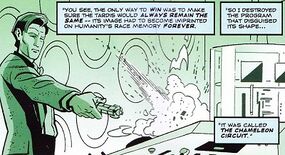
In any case, the defining characteristic of the Doctor's TARDIS was that its chameleon circuit had broken after assuming the shape of a police box in 1963 London. (TV: "The Cave of Skulls") The Eleventh Doctor sabotaged the chameleon circuit before the TARDIS left 1963 London as part of a plot to foil the Prometheans so that the blue box shape was imprinted into the race memory of humanity. (COMIC: Hunters of the Burning Stone) Not knowing this, the First Doctor and Susan expressed surprise that it had not changed form when they arrived at a new destination. (TV: "The Cave of Skulls")
By his eleventh self, the Doctor was telling his companions that the chameleon circuit was working, but due to a fault, invariably assumed its customary police box shape:
It's camouflaged. It's disguised as a police telephone box from 1963. Every time the TARDIS materialises in a new location, within the first nanosecond of landing, it analyses its surroundings, calculates a twelve-dimensional data map of everything within a thousand-mile radius and then determines which outer shell would blend in best with the environment.... and then it disguises itself as a police telephone box from 1963.
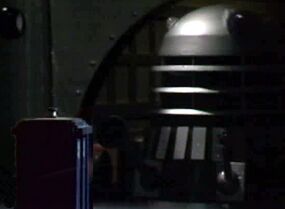
Friends and enemies could identify the TARDIS by its unvarying shape. The Daleks even used miniature copies of the TARDIS for target practice. (TV: Death to the Daleks) The Cybermen recognised it (TV: Earthshock), as did the Black Guardian's operative known as the Shadow. (TV: The Armageddon Factor) Sarah Jane also recognised it, which led to her reunion with the Tenth Doctor. (TV: School Reunion) Donna Noble was also on the look-out for the TARDIS. (TV: Partners in Crime)
On one occasion, an actual police box — namely, the last of its kind, which was situated on the Barnet by-pass — scared a group of invading aliens away from Earth when they mistook it for the Doctor's ship. (PROSE: Useless Things) Miss Kizlet's team faced "an embarrassment" when they thought the police box in Earl's Court the Doctor's space-time vehicle. (TV: The Bells of Saint John) Madge Arwell confused a normal police box for the TARDIS while helping the Eleventh Doctor find the TARDIS. (TV: The Doctor, the Widow and the Wardrobe) After accidentally aiding the Trickster by preventing her parents' deaths, Sarah Jane sought out the TARDIS to get the Doctor's help; however, as she time travelled to the 1950s, Sarah Jane mistook a regular police box for the TARDIS since they were "everywhere" at the time. (TV: The Temptation of Sarah Jane Smith)
Captain Jack Harkness was on the look-out for "a version of" the police box throughout the 20th and early 21st centuries to avoid meeting the Doctor before their initial meeting. (TV: Utopia) Members of LINDA also knew of the outer shape of the Doctor's TARDIS, as did the Abzorbaloff. (TV: Love & Monsters)
Because the police box shape was relatively easily recognised, the Doctor made several attempts to change the exterior of the TARDIS. None were particularly successful. In the end, he forewent changing how the TARDIS' outer shell looked by his ninth incarnation, deciding that he liked it. When Mickey Smith questioned the wisdom of leaving the TARDIS parked in the middle of Cardiff, thinking the appearance of a police box would draw unwanted attention, the Doctor reasons that it was not a concern--people would see a blue box in the middle of the city and walk past it, taking no further notice. (TV: Boom Town)
- These attempts are chronicled at chameleon circuit.
The exterior of the TARDIS changed shape when it entered siege mode. In this form, it took the shape of a cube etched with Gallifreyan writing with no way of getting in or out. If the TARDIS had insufficient power, this mode could not be turned off. (TV: Flatline)
Door
Generally, the TARDIS had two doors along one of the craft's four sides. They could open inward and outward. (TV: Time-Flight, The Ice Warriors, The Eleventh Hour, GAME: The Doctor and the Dalek) By the time of the Tenth Doctor, the doors could be opened by the snap of the fingers. (TV: Forest of the Dead, The Eleventh Hour, Day of the Moon) The Eleventh Doctor's companion Clara Oswald also attained this ability. (TV: The Day of the Doctor)
The right-hand door usually had a lock, (TV: The Sensorites, Spearhead from Space et al) although the lock was sometimes on the left-hand door, even though normal entry was still through the right. (TV: most serials prior to The War Machines)
On the left-hand door was a panel in which was a replica of a telephone used in real police boxes to summon the police. (TV: The Empty Child, The Bells of Saint John, The Time of the Doctor) While the Second Doctor inhabited the TARDIS the emergency phone was sometimes on the right-hand panel, but by the time of his adventure on Dulkis, it had returned to the left-hand door. (TV: The Dominators) The TARDIS once communicated with Timothy Dean using it's phone. (PROSE: Human Nature) Although during the Doctor's ninth incarnation this phone was (usually) non-functional, (TV: The Empty Child) by his eleventh incarnation the phone could be used to send and receive calls. (TV: The Day of the Doctor, The Time of the Doctor,Time Heist) A sign on this small door offered instructions on use of the phone. (TV: Logopolis)
The Second Doctor once entered through the top of the TARDIS, by lifting a panel on which the roof lamp rested. (COMIC: Peril at 60 Fathoms) He also tried to enter through the back panels, the occasional cat flaps and once through the central beacon. It was indicated that these would usually work, but did not in this case. (PROSE: Heart of TARDIS)
On most occasions, the left-hand door was set to a fixed position. Likewise, the windows on the door were most often seen in a closed position, though the First Doctor sometimes opened them. (TV: The Dalek Invasion of Earth)
The left-hand door was sometimes used for egress and the right-hand one stayed in a fixed position. (TV: The Aztecs)
Sometimes both doors could be pushed (TV: Rose, Father's Day) or pulled open. (TV: The Runaway Bride, The Beast Below, The Christmas Invasion)
The windows on the doors and around the exterior could be opened, at least during the First Doctor's tenure. (TV: "World's End", "Desperate Measures", "The Centre")
During the Doctor's first incarnation, a faded St John Ambulance logo could be seen on the door, even though it was sometimes barely visible under a layer of paint. During his second incarnation, it was not present. (TV: The Dominators onwards) When the TARDIS regenerated itself at the start of his eleventh incarnation, a new St John sticker appeared on the door. (TV: The Eleventh Hour)
The exact wording on the sign on the telephone door varied slightly over time — once it, and the writing otherwise on the front of the TARDIS, was changed to read BAD WOLF. (TV: Turn Left) When the TARDIS "regenerated" consequent to the Tenth Doctor's regeneration, this sign became backlit. (TV: The Eleventh Hour onwards)
By the time he was going to have the chameleon circuit repaired by the Logopolitans, the Fourth Doctor had installed a handle on the telephone panel on the left-hand door. This remained a subtle, if functional, part of the design. (TV: The Empty Child)
At some point prior to arriving to his unexpected death in San Francisco, the Seventh Doctor affixed a small handle to the right-hand door. (TV: Doctor Who) This handle persisted after the "regeneration" of the TARDIS consequent to the arrival of the Eleventh Doctor. (TV: Rose onwards)
The Eleventh Doctor somehow fixed the TARDIS doors to accommodate his robotic T-Rex companion Kevin, although it was never explained how. (COMIC: When Worlds Collide)
If the TARDIS entered siege mode, the door disappeared entirely. (TV: Flatline)
Lock and key
- Main article: TARDIS key
Operation
Entry to the Doctor's TARDIS was usually effected by inserting a key into a lock, just as would be expected with a real police box. However, the lock did not respond to police-issued keys. (TV: Black Orchid, Blink)
Susan suggested that the key forced the user to insert it precisely or the lock would self-destruct. (TV: "The Survivors") Later, the lock had a metabolism detector, preventing Brigadier Lethbridge-Stewart from using the key. (TV: Spearhead from Space)
It could be opened with the standard Gallifreyan key for its outdated model. (TV: The Invasion of Time)
Rare individuals managed to break open without a key. Among those, the companion Adric through lock-picking (TV: Logopolis) and the gastropod Mestor through its psychic power. (TV: The Twin Dilemma)
According to Clara Oswald, the Doctor kept seven separate TARDIS keys hidden throughout the TARDIS. (TV: Dark Water)
Design and features
The external design of the key changed over time. It usually appeared to be an ordinary Yale lock key. (TV: Spearhead from Space, Rose, and others) However, it occasionally appeared to have a more ornate, Gallifreyan motif. (TV: Planet of the Spiders, Ghost Light, Doctor Who)
The key could be modified to track and locate the TARDIS, allowing the Doctor to find the TARDIS if it was within a hundred years of his position. (COMIC: The Forgotten) The key was known to express a link to the TARDIS by glowing or becoming hot to the touch. (TV: Father's Day, The Eleventh Hour)
At one point, the Tenth Doctor installed a system that let him lock the TARDIS remotely using a fob (as a joke, the TARDIS roof light flashed and an alarm chirp was heard, similar to that used on vehicles on Earth). He could open the door remotely. (TV: The End of Time) He also discovered, with the help of River Song after their adventure in the Library, that the door would open when he snapped his fingers, (TV: Forest of the Dead, Day of the Moon) although this function was not used consistently until his eleventh incarnation. (TV: The Eleventh Hour, Day of the Moon, The Doctor's Wife) Clara Oswald also displayed this ability twice, (TV: The Day of the Doctor, The Caretaker) using the ability to shut the doors the second time after the Twelfth Doctor did it to open the doors. (TV: The Caretaker) The Doctor has also shown the ability to summon the TARDIS with the key in his eleventh and twelfth incarnations: the Eleventh Doctor used the key to materialise the TARDIS around himself and Clara Oswald to save them from the Weeping Angels, (TV: The Time of the Doctor) while the Twelfth Doctor used the key to summon the TARDIS to save him from a free-fall, skydiving through the doors once it appeared nearby. (TV: Death in Heaven)
If modified properly, the TARDIS keys exhibited perception filter properties of the TARDIS. (TV: The Sound of Drums)
Interior configuration and appearance
The TARDIS interior went through occasional metamorphoses, sometimes by choice, sometimes for other reasons, such as the Doctor's own regeneration. (PROSE: Invasion of the Cat-People, TV: The Eleventh Hour)
Some of these changes were physical in nature (involving secondary control rooms, etc.), but it was also possible to re-arrange the interior design of the TARDIS with ease, using the Architectural Configuration system. (TV: Logopolis, Castrovalva, AUDIO: Relative Dimensions) The Fifth Doctor called this changing "the desktop theme". (TV: Time Crash) When the "desktop theme" was changed, the control room would flash with light and the newly selected version would take its place. (TV: The Day of the Doctor) The TARDIS archived disused (and yet-to-be-used) control room configurations. (TV: The Doctor's Wife) The TARDIS could also create and modify rooms on its own accord; for example, to prevent part of the Architectural Configuration System from being stolen, and to preserve passengers from threats by creating copies of the control room to house them in. (TV: Journey to the Centre of the TARDIS)
Roundels
The TARDIS interior walls generally consisted of roundels — circular or hexagonal indentations that lined the TARDIS console room's interior walls and sometimes the walls deeper in the ship's interior. Some roundels concealed TARDIS circuitry, devices, or lights. (TV: The Wheel in Space, Death to the Daleks, Logopolis, Castrovalva, Arc of Infinity, Terminus, Enlightenment,Vengeance on Varos, COMIC: Kane's Story) At least one large roundel functioned as a scanner. (TV: The Claws of Axos, The Beast Below) On the whole, though, the Doctor had little clue as to their purpose, though his later incarnations (the Tenth, Eleventh and Twelfth Doctors) admitted to loving and missing them from the desktops of their TARDISes. (TV: The Day of the Doctor, Deep Breath)
Mass
The TARDIS' exterior was always lighter than the "true weight" of its interior. According to the Twelfth Doctor, "If the TARDIS were to land with its true weight, it would fracture the surface of the Earth." (TV: Flatline) The TARDIS was said by Romana II to weigh fifty thousand tonnes in Alzarius' gravity. (TV: Full Circle) "[S]eventeen thousand tons of thrust" was jettisoned for the TARDIS to escape Event One. (TV: Castrovalva) One time, when the TARDIS mapped its interior dimensions onto its exterior ones — making it the same size outside as inside — it was larger than Gallifrey. (PROSE: The Ancestor Cell) It was once described by the Eleventh Doctor as being infinite, as new areas could be created and therefore add more weight. (TV: Journey to the Centre of the TARDIS) The Twelfth Doctor once adjusted the TARDIS' relative gravity so that Clara could pick it up. This decrease of weight allowed the TARDIS to be light enough that the Doctor was able to, literally, move it by hand. (TV: Flatline)
Control room
- Main article: TARDIS control room
The control or console room of the Doctor's TARDIS was the space in which the operation of the craft was usually effected. It was dominated by a large, hexagonal console, typically in or near the middle of the room. The room held a scanner for viewing the outside and offered immediate access to the exterior through a set of doors. According to one source, the trip from the console room to the outside required the passenger to step through the real world interface at the heart of the outer plasmic shell. (TV: Logopolis) Many other accounts demonstrated that the doors were just doors, though the TARDIS was cocooned in a breathable atmosphere. (TV: The Runaway Bride, The Stolen Earth, The Beast Below, HOMEVID: Meanwhile in the TARDIS) On one occasion, when the TARDIS' exterior dimensions shrank, so did the door on the inside. (TV: Flatline) On another occasion, when the extrapolator shielding could easily be breached by the weaponry of the New Dalek Empire, who were "[e]xperts at fighting TARDISes", the Tenth Doctor described "that wooden door" at that point as being "just wood". (TV: Journey's End) Queen Elizabeth I once pointed out that while the Tenth Doctor's TARDIS was bigger on the inside, the door wasn't, and her head was nearly taken off when the Doctor rode out of the TARDIS with Elizabeth on a Zygon which took on the body-print of a horse. (TV: The Day of the Doctor)
There were many variants of the Doctor's control room. Indeed the Doctor's TARDIS had more than one control room. The TARDIS itself said it had over 30 different versions in storage; being a different kind of temporal being, it could "archive something that hasn't happened." Idris telepathically told Rory how to go to the old console room which was the Ninth and Tenth Doctor's console room. (TV: The Doctor's Wife)
Other rooms
Accommodations
Some of the companions shared accommodations. (TV: The Edge of Destruction, The Doctor's Wife) Many companions had their own rooms in the TARDIS, decorated to their tastes. (TV: Meglos, Earthshock) Some of the companions were given previously used rooms; in the case of Turlough, it is most likely because Tegan didn't know where to find other rooms. (TV: Terminus) Romana's room was jettisoned. (TV: Logopolis) According to one account, the Doctor provided a room for each companion and stored it in a holding ring even after they departed from him. At some point, the Eighth Doctor deleted every room but one. (AUDIO: Relative Dimensions)
The Eleventh Doctor was asked if he had a room, but did not answer. The other bedrooms had also been deleted by House when it possessed the TARDIS, leaving Amy and Rory's the only one. (TV: The Doctor's Wife) Amy and Rory's original (pre-House) quarters were furnished with bunk beds, much to their consternation. Nevertheless, the couple quickly conceived River Song despite the less than optimal marital accommodations. They secured a proper bed after escaping from House when the Doctor agreed to give them one when reassigning them to a new room. (TV: The Doctor's Wife, A Good Man Goes to War) The Twelfth Doctor was implied to have a room (COMIC: Four Doctors)
Library
- See also: the Doctor and books
There was a library in the TARDIS. (PROSE: War of the Daleks, All-Consuming Fire, The Dimension Riders, AUDIO: The Witch from the Well) Its books included Brave New World by Aldous Huxley, (PROSE: The Wheel of Ice) Jane's Spaceships, (PROSE: War of the Daleks) Every Gallifreyan Child's Pop-Up Book of Nasty Creatures From Other Dimensions, (PROSE: All-Consuming Fire) The Time Machine by H. G. Wells, (TV: Doctor Who) Robinson Crusoe, (PROSE: Heart of TARDIS) The Murder of Roger Ackroyd by Agatha Christie (signed first printing, with last page missing), War and Peace, The Wonderful Wizard of Oz, The I-Spy Book of British Birds, (AUDIO: Storm Warning), Can you forgive her?, the James Bond novel You Only Live Twice, (AUDIO: Zagreus), A History of the Varaxil Hegemony, (AUDIO: The Witch from the Well) the Encyclopedia Gallifreya, The History of the Time War, (TV: Journey to the Centre of the TARDIS) Wisden, A Brief History of Time, (PROSE: Fear of the Dark) Ludowig's Histories of the Dalek Imperium, and the only signed copy of The Quarry in the universe. (PROSE: Keeping up with the Joneses) The Doctor also possessed a copy of Christie's Death in the Clouds published in the year 5 billion (though this was kept in a trunk, stored under the grates of the control room, and at least not originally in the Library), (TV: The Unicorn and the Wasp) a complete set of all 11 Harry Potter novels (PROSE: The Gallifrey Chronicles) and a book entitled Advanced Quantum Mechanics that had an image of the TARDIS in its police-box camouflage on the dust jacket. (TV: The Day of the Doctor) His library also had books by Capek and Capote. (PROSE: The Blood Cell)
The Doctor also kept his Five Hundred Year Diary in the library. (AUDIO: The Young Lions)
Sometimes small items other than books were also stored in the library. For instance, the Doctor kept there his secateurs filed under "B" for Capability Brown. (AUDIO: The Witch from the Well)
The Eleventh Doctor tore out the final pages of each book "so the story will never end [for him]". (TV: The Angels Take Manhattan) Unlike his successor, however, the Tenth Doctor loved a book with a death at the end, particularly biographies; Donna Noble pointed out that it was "very [Doctor]" to always have death at the end. (TV: Silence in the Library) The Tenth Doctor in fact specifically protested about his copy of The Murder of Roger Ackroyd missing the last page. (TV: The Unicorn and the Wasp)
During the time of the Tenth Doctor, there was a specific desk that, no matter where it was moved, always got rained on by a cloud layer in the upper stacks. The Doctor placed a saucepan on the desk to catch the water and keep psychic paper from mouldering because it produced psychic mould that would eventually turn into psychic mushrooms. (PROSE: Keeping up with the Joneses) By the time the Eleventh Doctor was recovering from regeneration after-effects, the pool fell into the library after a crash-landing. (TV: The Eleventh Hour) Clara Oswald also hid in the library when she was running from time zombies. (TV: Journey to the Centre of the TARDIS)
The console room had a library at the end of the Seventh Doctor's life and the start of the Eighth Doctor's. (TV: Doctor Who) The Twelfth Doctor showed similar taste, refurbishing his console room with book shelves. He often took out a book relevant to a situation. (TV: Deep Breath, Robot of Sherwood, Listen, etc)
Wardrobe
The Doctor kept some of the clothes from his previous regenerations, as well as clothing for other people in the TARDIS wardrobe. (TV: Pyramids of Mars, The Androids of Tara, The Twin Dilemma, Time and the Rani, The Unquiet Dead, The Christmas Invasion, The Idiot's Lantern, Victory of the Daleks, AUDIO: No Place Like Home, COMIC: Laundro-Room of Doom) Its appearance changed over time, appearing as either a small closet, (TV: The Twin Dilemma), a storage room. (TV: Time and the Rani), or a proper walk-in closet (TV: The Christmas Invasion) The War Doctor talked about "wardrobes", suggesting there could be more than one. (PROSE: Engines of War)
Some of the clothing was picked up during travels (TV: Spearhead from Space, Doctor Who, The Fires of Pompeii, The Eleventh Hour, Deep Breath) or left by ex-companions. (TV: Pyramids of Mars, Army of Ghosts, Partners in Crime, Space) It contained clothing from various times and environments, to suit where and when the TARDIS' occupant(s) found themselves. (TV: The Talons of Weng-Chiang, The Mark of the Rani, Ghost Light, The Curse of Fenric, The Unquiet Dead, Human Nature, Planet of the Ood, The Unicorn and the Wasp, The Power of Three, The Great Detective, etc.) The Tenth Doctor explained to Gabby Gonzalez that the TARDIS shopped on her own by landing in stores after hours, collecting clothes to make copies of it, and returning the originals to avoid theft. (COMIC: Laundro-Room of Doom) These proved useful on numerous occasions for the Doctor's companions, many of whom left on their travels without bringing many clothes of their own. (TV: The Twin Dilemma, The Greatest Show in the Galaxy, Victory of the Daleks) And the Doctor has often availed himself of its selection when attempting to define a style for himself, post-regeneration; (TV: Robot, The Twin Dilemma, Time and the Rani, The Christmas Invasion) and possibly Romana as well. (TV: Destiny of the Daleks) The Fifth Doctor, however, discovered his wardrobe in an unidentified anteroom. (TV: Castrovalva)
At least some of the clothes had pockets that were bigger on the inside. (TV: The Runaway Bride)
By the time of the Doctor's fifth incarnation, the TARDIS was equipped with replicator technology, which allowed to copy clothing. (AUDIO: The Toy)
Jo Grant once spent approximately two hours going through the wardrobe trying on different outfits. She considered many of them "groovy." (AUDIO: Ghost in the Machine)
During Ace's time in the TARDIS it was apparently right next to the control room. (TV: The Greatest Show in the Galaxy) The War Doctor had once forgotten where the wardrobe was located, ended up giving incorrect directions. (PROSE: Engines of War) When the Ninth Doctor was in Cardiff on 24 December 1869, he gave incredibly long directions to Rose Tyler to get to the wardrobe; her being able to remember them was nothing short of a miracle. (TV: The Unquiet Dead) When the Tenth Doctor was travelling with Gabby, the wardrobe was located next to the laundry room. While walking to the laundry room, Gabby asked if the boot cupboard was the wardrobe, to which the Doctor explained that the "wardrobe's next door along -- I think. Might've moved it." (COMIC: Laundro-Room of Doom) By the time of the Eleventh Doctor's date with River Song following the TARDIS' repair, it had changed location. The directions that he gave River were considerably shorter. (TV: The Eleventh Hour; HOMEVID: First Night)
In the Eleventh Doctor's second console room, the wardrobe relocated to a chest beneath the main console. (TV: The Bells of Saint John) The Doctor once changed out of his outfit and into his standard clothes incredibly fast, and when asked by Clara how he changed so quickly, he replied "Wibbly-wobbly wardrobe." (PROSE: Shroud of Sorrow)
Cloister bell/room
The Cloister Room was related to the Cloister Bell, which sounded when disaster was imminent. The room appeared to be ancient with benches on the sides of the room and plants growing on the crumbling pillars. The Fourth Doctor visited this room with Adric shortly before his regeneration. (TV: Logopolis)
The Fifth Doctor used to hide from Tegan Jovanka in the Cloister Room. (AUDIO: No Place Like Home)
Ace attempted to relax in the Cloister Room, but gave up when the bell would not stop ringing. (PROSE: Cat's Cradle: Witch Mark)
When the TARDIS interior went through a metamorphosis, the Cloister room became a grand and gothic room, similar to a place of worship, with an interface with the Eye of Harmony. (TV: Doctor Who)
The Tenth Doctor later implied that the room had reverted back to its garden state. He explained to Gabby that the dirt molecules in their clothes would be deposited as fertiliser for "the cloisters" by the Laundro De-mat. (COMIC: Laundro-Room of Doom)
Holding ring
- Main article: TARDIS holding ring
The holding ring was a storage area of the TARDIS which let the Doctor preserve certain rooms. When Lucie, Susan and Alex investigated it, the ring contained the rooms of many of his former companions, preserved as they had been the last time the companions were in the TARDIS. The rooms were saved in chronological order, suggesting that Susan was indeed the Doctor's first companion. Susan later teased her grandfather, calling his habit of saving rooms overly sentimental. He suggested that the ring was one of the few ways his time-travelling life allowed him to put down roots. After Susan, Alex and Lucie departed the TARDIS for new adventures on Earth, the Doctor reconsidered the wisdom of keeping so many rooms in stasis. Insisting to himself he needed to look towards the future, he deleted all the rooms on the holding ring — "except that one". (AUDIO: Relative Dimensions) The Doctor's penchant for such archiving recalls the TARDIS's policy of archiving past and future console rooms, though whether out of nostalgia or, as it states, "for neatness" is unclear. (TV: The Doctor's Wife)
Swimming pool
- Main article: TARDIS swimming pool
The TARDIS had a swimming pool. It was used by Leela and Borusa to hide from the Sontarans. Leela mistakenly called it "the bathroom", confusing the pool for a bathtub. (TV: The Invasion of Time) Peri froze the water with liquid nitrogen to turn it into an ice skating rink (AUDIO: The Roof of the World) It was later jettisoned due to leakage, which Mel found bothersome. (TV: Paradise Towers)
It was replaced some time later. (GAME: Destiny of the Doctors) After the TARDIS' crash following the Doctor's tenth regeneration, the pool's water — or perhaps the pool itself — fell into the library. After the TARDIS had fixed itself, the swimming pool was restored but the Doctor did not know where it was; he stated that the Wardrobe contained "clothes, and, possibly, a swimming pool". (TV: The Eleventh Hour) He eventually found it, and offered to go and swim a few laps to give Amy and Rory some privacy. (TV: Amy's Choice) Later, to save River Song after she had leapt off a New York skyscraper, the Doctor had Amy and Rory open all the doors leading to the pool to cushion River's landing in the sideways TARDIS. (TV: Day of the Moon) The Doctor said he got rid of it to "give the TARDIS a bit of welly" when going outside the universe. (TV: The Doctor's Wife) However, after the TARDIS has changed once again (TV: The Snowmen), the swimming pool has "rebuilt"' and Clara Oswald walked by and saw it when she was trapped in the TARDIS after a salvage team damaged the ship. (TV: Journey to the Centre of the TARDIS)
Zero Room
- Main article: Zero Room
The Zero Room was unaffected by the outside world and smelled of roses for some reason unknown even to the Doctor. It was a refuge for Time Lords undergoing regenerations in danger of failing. It was accidentally jettisoned along with other rooms in the TARDIS to escape from Event One. (TV: Castrovalva) A new one was eventually built. (AUDIO: Renaissance of the Daleks) The Sixth Doctor placed Charley Pollard in it in order to cure her from the virus she was infected with during their visit to the Amethyst Viral Containment Station. (AUDIO: Patient Zero) The Seventh Doctor was able to purge the TARDIS of a demonic infection by subtly linking the tertiary console to the Zero Room, cutting the console off from the rest of the ship so that the Doctor could take action against the infection without it being aware of his actions (PROSE: Deceit). The War Doctor allowed Karlax to finish regenerating from exposure to the vacuum of space in it. (PROSE: Engines of War)
Kitchen
- Main article: TARDIS kitchen
A food machine area was originally near (but not in) the console room. (TV: The Edge of Destruction and others) The food machine was apparently reinstalled at some point, since it was among the components Thomas Brewster sold to the crew of the Gamma while in possession of the Fifth Doctor's TARDIS. (AUDIO: Time Reef) Later, the TARDIS had a full kitchen (AUDIO: Relative Dimensions, COMIC: Sticks & Stones) which included a refrigerator. (COMIC: The Whispering Gallery) The Eleventh Doctor pointed out the location of the kitchen to Captain Avery after letting him into the TARDIS. (TV: The Curse of the Black Spot) Evidently this amenity was not a top priority for visitors as the Doctor noted that Clara's early inquiry about whether the TARDIS had a kitchen was "(a) first". (TV: The Snowmen) According to Romana, the Fourth Doctor rarely used the kitchen. (HOMEVID: Shada)
Laundry room
Mel said that the Doctor used the TARDIS laundromat to wash his clothes. (AUDIO: The One Doctor) Ba's ship once became trapped in the TARDIS laundry room for four weeks. (PROSE: A Life in the Day) When the Eighth Doctor's coat was damaged by Tractites the TARDIS laundry machine repaired it. (PROSE: Seeing I) The Tenth Doctor took Gabby to the TARDIS laundry room after their trip to Quomippins, calling it the "Landro-Demat". He explained that the washing machine worked by dematerialising and analysing the clothes and then separating out the dirt and putting everything back together which meant nothing ever came out damaged. It also had an option that enabled the user to scent their clothes with any of thousands of scents, but it did have a glitch that caused the clothes to rumple. After accidentally putting his sonic through the wash, it caused a mud monster avatar to develop from their dirty clothes and at the end of the cycle, the Doctor's shirt ended up with Gabby's flower print and her shirt ended up with stripes. (COMIC: Laundro-Room of Doom)
Flora and fauna
The Doctor had a botanical house which contained a man-eating plant. This plant ate a Sontaran. (TV: The Invasion of Time)
There was a large garden designed by the Doctor using block-transfer computation that needed to be tended — it contained bougainvillaea, Draconian myrtle hedges and Vendican bladder-pods, plus a stream and set of swings. The Eighth Doctor said he once allowed an entire incarnation to pass without maintaining it. (AUDIO: Scaredy Cat) During the time when Jason and Dr. Who controlled the TARDIS, Jason almost drowned Wolsey in the garden's pond. (PROSE: Head Games)
By the time of his Eighth Incarnation the Doctor's TARDIS had a Butterfly Room. (PROSE: Vampire Science) It was a huge room with a hillside and a meadow in it, it housed "about a billion butterflies". The Doctor often sat in a wicker chair at the top of the hill. After spending three years in Oliver Bainbridge Functional Stabilisation Centre he recuperated in the Butterfly Room. (PROSE: Seeing I)
During the time that the Tenth Doctor travelled alone after the loss of Donna Noble, the TARDIS spontaneously generated a park where he spent two weeks growing oak trees. After using the artificial sun to make the branches spell the name "Rose", the Doctor decided it was time to move on from the park. (PROSE: Keeping up with the Joneses)
During an attack from a temporal mine, the TARDIS shared its pain with the Tenth Doctor by vaporising the aquarium which caused him
